In the neighbourhood, they used to call Mohammad Al-Bakr “The Prince”. The scrawny 11-year-old, the only son of Ramez and Salwa, was in line to take over the fisherman’s mantle that had passed down three generations and was now, due to his father’s chronic back problems, soon to be his. He was good at school, and much of his free time was spent at the nearby beach, where all the Al-Bakr children swam and played football. When it was busy, he made some pocket money by selling tea on the beach, and it was his dream one day to open a fish shop.
In a household where money was scarce, where Mohammad had just a single pair of trousers and two T-shirts, already there was talk about him becoming the breadwinner. A life at sea beckoned. “Our kids, their whole world is the water. They live their lives down there,” says Samia, the boy’s aunt, sitting in a spartan room in the family home. Beside her is Salwa, Mohammad’s mother, who is swaying silently, her legs crossed beneath her on the bed. Around them are more than 20 women and children from the extended family, gathered in grief. “I told them not to go, but he insisted,” Salwa whispers. “He just wanted to play.”
On Wednesday afternoon, Mohammed was among a group of children who were playing on the Gaza city beach when a missile struck a shack on the harbour. The children ran away from the blast towards a hotel beyond some deserted beach cafes, according to witnesses, but within an instant a second missile struck, this one closer to the running children. Four cousins, all under 11, were killed on the beach that afternoon. Four more were injured.


The Al-Bakr family buried their children within hours of their deaths and returned to the family home. But their longest day wasn’t over yet. At 5am, when everyone was in bed, the west-facing windows were suddenly blasted in. An Israeli “knock on the door” warning had fallen on the roof of a house across the road. People recognised it immediately, and they were fleeing. The children, screaming and crying, fell over each other in the panic to run down the street. A few minutes later, an Israeli rocket exploded on some open land across the road, leaving a 10-foot crater and causing extensive damage to adjacent homes. “We just stood there in the street,” says Samia.
The terror of daily life
Ali Abu Hasira watched it all unfold on the beach that day. He’s 42, but he has been fishing here since he was 12, and he knew each of the boys and their family. He points to the spot where the first missile fell, then the second one. He describes how two of the children were flung more than 15 metres in different directions by the force of the blast. “The Israelis don’t care about anybody,” he says. Around us, the beach is deserted. Normally there would be up to 30 fishermen on foot and more than 100 out at sea. Today there are none.”
Heart-wrenching stories of the traumas inflicted by the latest confrontation between Israel and Hamas have abounded this week. Local health ministry figures show that, of the 260 people who were killed in Gaza, the great majority were civilians and 48 were children. Yet the killings on Gaza beach touched a nerve. Outside the enclave, they drew revulsion. Inside, they seemed somehow to multiply the terror of daily life. If four children playing on a beach could be hit, then anyone could.
Even the smallest decision was freighted with risk. Should you stay in, knowing that residential homes have taken the brunt of the bombardment (sometimes taking neighbours’ houses with them) or go out and risk walking down the wrong street at the wrong time?
When 27-year-old Riwaa Bassal opened her Facebook last Saturday night, she read that her younger brother Mohammed had been killed when a bomb hit a building he was walking past in the district of Zeitoun. “My brother was walking in the street,” she says, speaking in the classroom of a UN school that has been converted into a shelter for Gazans who left their homes due to heavy bombing. “He wasn’t carrying a rocket. He was walking peacefully.”
Vast bomb sites There was terror and fear, but boredom too. When a five-hour ceasefire, agreed by Israel and Hamas at the UN’s request, came into effect on Thursday morning, people
spilled out onto the streets. For 10 days, Gaza had been deserted, the shops closed and cars few and far between. Most people hadn’t left their homes. Suddenly the central market was bustling, the traffic jams returned and life took on its old rhythms, however briefly.
As they stocked up on food and other essentials, people admitted that after more than a week of sitting inside waiting for the bombs to fall, they were relieved to be out again, and to catch up with friends and family. “We got bored at home,” said Ayman, whose men’s clothes shop at the entrance to Zawiya market had opened for the first time in 10 days even though he didn’t expect to do any business.
“We’re not selling anything,” he said, pointing to the huge stock of jeans and shirts he imported from Turkey in the hope of a busy Eid. “People are only buying food and drink, but we opened so we could be outside and see people.”
In normal times, daily life in this crowded, impoverished sliver of land is a struggle. With the bombings, the strip has been left disfigured as well. Families sift through vast bomb sites where their homes once stood. Charred rockets sit in craters at the side of the road. At the overstretched Shifa hospital, there are barely enough spaces in the ramshackle morgue to meet demand. Children in shock – inert, rigid, exuding fear – are a disturbingly common sight.
Yet the real tragedy is that these dystopian scenes, like much else about the latest conflagration, in so many ways recall the events in 2009 and 2012, when Israel and Hamas last confronted one another from either side of the buffer zone. And while both sides will claim to have made short-term gains, few expect the landscape that emerges once the smoke has cleared to be meaningfully different to that of 10 days ago.
Last Sunday night in Tel Aviv, big crowds turned out to watch the World Cup final on big screens in expensive bars and cafes around the city. With its elegant beachfront, its clean, orderly streets and its thriving social scene, Israel’s commercial heart felt like a European Mediterranean city that night – and a world away from the chaos just a few hours to the south. But while only one Israeli has been killed by a militant rocket from Gaza (a 37-year-old who was delivering food to Israeli soldiers near the border with Gaza, killed by a fragment of mortar fire) and the Iron Dome missile defence system has succeeded in shielding urban areas, the psychological effect of hearing wailing sirens in public places several times a day weighs heavily on public opinion.
Up to 90 per cent of Israelis, according to opinion polls, support the government’s actions in Gaza. Notwithstanding the pressure prime minister Binjamin Netanyahu faces on his right flank, the public is firmly behind him. For Hamas, the conflict brought the risk of huge losses but also some strategic opportunities. Hamas has been at a low point recently. Isolated in the wake of the upheaval in Egypt and the civil war in Syria, and under financial pressure since the closure of Gaza’s southern border with Egypt, which deprived it of goods and tax revenues, the organisation recently opted to transfer formal authority over the civic administration in Gaza to the Palestinian leadership in Ramallah. That led to a reconciliation agreement between Hamas and the Palestinian Liberation Organisation on terms that were seen as casting Hamas, the winner of an election in Gaza in 2006, as the weaker partner.
Now, however, it finds itself back in a central role, presenting itself in a defensive posture and enhanced in the eyes of its supporters.
As columnist Chemi Shalev wrote in the liberal Israeli newspaper Haaretz this week, "The Israeli bombing raids on Gaza and the casualties inflicted on its civilian population have cast Hamas once again as the main pillar of resistance against the evil Zionists and placed them in perfect position to play hard to get in the upcoming efforts led by Secretary of State John Kerry to broker a cease fire."
Mahmoud Abbas, the Palestinian Authority chairman, appears sidelined. On the streets of Gaza this week it was difficult to find anyone who would criticise Hamas, at least in public. “May God protect Hamas,” says Ghalia al-Sawarka, who left her home in the north of Gaza in the middle of the night after the Israelis dropped leaflets warning of a bombardment in the area. “Without Hamas, we’d be completely lost.”
On the ground in Gaza, the situation changes by the hour. Thursday began with a ceasefire and ended with Israel mounting a ground operation that involved tanks, drones, fighter jets, Apache helicopters and naval gunships. So far that operation has been limited. Israeli government ministers have said it is focused on militant tunnels along the border, and an Israel Defence Forces spokesman said it was not aimed at “toppling Hamas”.
The widespread belief is that Netanyahu does not want to re-occupy the strip, but Israel may be calculating that by tightening its grip and ensuring Hamas cannot resupply, the militants will be forced to agree to a ceasefire.
Hamas warns that Israel will “pay a heavy price” for the ground invasion and insists it will only agree to a truce if Israel agrees to lift the siege of Gaza and to release the dozens of prisoners freed in the 2011 deal for captured Israel soldier Gilad Shalit, who were rearrested recently in the wake of the killing of three kidnapped Israeli children.
Neither side has an interest in prolonging the war; in that sense, their needs are aligned. For Israel, a full invasion would risk heavy casualties and require a huge long-term investment in the security and development of the strip. Domestic public opinion might baulk at that, while removing Hamas by killing its leaders would run the risk of seeing it replaced with something even more unpalatable to Israel.
On the other side, Hamas also needs the conflict to end. Its arsenal is depleting fast, Gazans are growing impatient and there are signs of divisions between the political and military camps within the organisation.
Both sides need a way out, yet the military momentum is building all the time. The longer diplomacy stalls, the higher the chances that Israel and Hamas will be drawn into a deadly, drawn-out war that both sides have an interest in averting.












